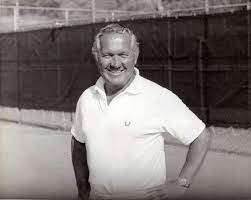What is Racquetball?
Racquetball is a game played with a stringed racquet, a rubber ball and for safety, goggles. The game is played in an enclosed court which measures 40 feet long, 20 feet wide, and 20 feet tall. It can be played one-on-one with 2 people. This is called a singles match. It can be played with 3 people, and this game is called Cut-throat. The game played with 4 people, 2 people on each team is called a Doubles match.
The games are played to 15 points in most cases and you only have to win by one point. Players get points when they win a rally after they (or their teammate) serve. When you win a rally and did not serve, you now have won the privilege to serve and add points to your total. A match is a 3 game series. In match play, the player with 2 games won, wins the match. If the match goes to a 3rd game, this deciding game is played to 11 points instead of 15 points.
The fun and unique part of this game is that it is one of the few racquet sports played without a net and all the surfaces on the court are “in-bounds”. You can use the floor, all the walls, and the ceiling to win points.
For more information about scoring and how to play for beginners, click here.
Who created the game of Racquetball?
The game of racquetball is a derivative of the games, squash, tennis, and handball. Joseph George Sobek was looking for a faster-paced, more explosive game to play and used his experience with these other games to craft the game of racquetball as it is played today. There are a couple of different accounts regarding the creation of the ball used. Some say that Joe was a worker at a rubber factory in the 1940s and designed a ball. Another possibility has Joe calling in a favor from a friend and the ball was created at the Seamless Rubber Co. after many iterations. In comparison, racquetballs and squash balls are both hollow rubber balls but the racquetball is about 40% larger.
Joseph Sobek (April 5, 1918 – March 27, 1998) was a professional tennis and handball player, He invented the game of racquetball in 1949. Joe is known as the “father of Racquetball”. Joe originally called this game “paddle rackets”.

Comparing the Racquetball ball, the Squash ball, and the American Handball
Racquetball ball:
2.25 inches in Diameter / 1.4 oz.
57.15 mm in Diameter / 39.7 grams
Squash ball:
1.57 inches in Diameter / .88 oz.
40 mm in Diameter / 24 grams
Handball ball (smaller, heavier, and denser than a racquetball):
1.875 inches in Diameter / 2.3 oz.
47.6 mm in Diameter / 65 grams
For more information on the colors of racquetballs and what they mean, click here.
According to the USAR Rulebook, these are acceptable ball specs:
Rule 2.2 Ball Specifications (a) The standard racquetball shall be close to 2 1/4 inches in diameter; weigh approximately 1.4 ounces; have a hardness of 55-60 inches durometer, and bounce 68-72 inches from a 100-inch drop at a temperature of 70-74 degrees Fahrenheit.

When was the game of racquetball first played? What were the original racquets like?
After Joe Sobek settled on a ball prototype and a set of rules, it was time to design a racquet that would provide the speed and accuracy the game required. Joe’s first racquets were stringed racquets, made of wood with a leather-wrapped handle. To promote the game, he had some built and distributed to YMCA’s where the game was adopted and began to take off. The first games were played in the North Eastern part of the United States, in the Connecticut/Massachusetts area in the early 1950s.
Racquetball racquet companies continue to try and lead the industry by creating lighter and stronger racquets. Since Joe Sobeks’ original racquet, there have been many racquet advances. In the early 1970s, the Aluminum Alloy frame was created and shortly after was replaced with the Fiberglass Frame. Around 1980, the Graphite frame hit the scene which provided the strength and durability for the introduction of oversized frames which were introduced in the mid-1980s.
According to the USAR Rulebook, these are acceptable Racquet Specs:
Rule 2.4 Racquet Specifications
(a) The racquet frame, including the bumper guard and all solid parts of the handle, may not exceed 22 inches in length. The racquet frame may be any material deemed safe.
(b) Using a racquet frame that exceeds 22 inches will result in forfeiture of the game in progress or, if discovered between games, forfeiture of the preceding game.
(c) The penalty for playing with a racquet frame that does not exceed 22 inches, but has a grip extending beyond the 22- inch limit, if noted during the course of a game, shall be a technical foul and a timeout to correct the problem. Subsequent violations will result in the loss of the game in progress. If a player challenges a racquet during a game that is found to be within the 22-inch limit, then a timeout is charged to the player who made the challenge. There is no penalty if the grip issue is noted and corrected before or between games.
(d) The racquet frame must include a cord securely attached to the player’s wrist. The wrist cord can be no longer than 18 inches as measured from one end of the cord to the other. When stretched to its maximum length, the cord cannot be longer than 24 inches. Players using non-complying cords will be charged with a time-out to make the necessary change and, if none remain, a technical foul will be assessed to make the change.
(e) The string of the racquet must be gut, monofilament, nylon, graphite, plastic, metal, or a combination thereof, and must not mark or deface the ball.
Speaking of Racquetball Strings, here is the string types used:
Multifilament:
‘Soft’ feel with great playability and comfort. Less durable than monofilament strings.
Example: Head Megablast
Monofilament:
Cheap and very durable but quite stiff.
Example: Gearbox Mono Premium
Kevlar:
The strongest, most durable string on the market. Recommended string type for the player who frequently breaks strings. Can also use as a mains string in a hybrid setup.
For more on racquetball racquet stringing, click here.


Absolutely pent written content, regards for entropy. “In the fight between you and the world, back the world.” by Frank Zappa.
Hello There. I found your blog using msn. This is a really well written article. I will be sure to bookmark it and come back to read more of your useful info. Thanks for the post. I will certainly comeback.
This site is really a stroll-by for all the data you needed about this and didn’t know who to ask. Glimpse here, and also you’ll definitely discover it.
Very interesting topic, appreciate it for putting up.
We’re a group of volunteers and starting a new scheme in our community. Your web site offered us with valuable information to work on. You have done an impressive job and our whole community will be grateful to you.
I always was concerned in this topic and still am, thanks for putting up.
I haven¦t checked in here for some time because I thought it was getting boring, but the last several posts are great quality so I guess I¦ll add you back to my daily bloglist. You deserve it my friend 🙂
Terrific paintings! This is the kind of info that are meant to be shared around the internet. Disgrace on the seek engines for now not positioning this post upper! Come on over and discuss with my site . Thanks =)
I am now not sure the place you are getting your info, however great topic. I must spend a while finding out much more or figuring out more. Thank you for fantastic information I used to be searching for this info for my mission.
Eryaman diyetisyenleri, sağlıklı beslenme alışkanlıkları geliştirmek ve kilo kontrolü sağlamak isteyen bireyler için önemli bir kaynak oluşturmaktadır.
Whats up are using WordPress for your site platform? I’m new to the blog world but I’m trying to get started and set up my own. Do you require any coding knowledge to make your own blog? Any help would be greatly appreciated!
hello there and thank you for your information – I’ve definitely picked up something new from right here. I did however expertise some technical points using this website, as I experienced to reload the site lots of times previous to I could get it to load properly. I had been wondering if your web hosting is OK? Not that I am complaining, but slow loading instances times will sometimes affect your placement in google and could damage your quality score if advertising and marketing with Adwords. Well I am adding this RSS to my e-mail and can look out for much more of your respective interesting content. Ensure that you update this again very soon..
I conceive other website proprietors should take this site as an model, very clean and good user pleasant style and design.
Rattling clear web site, regards for this post.
Hmm it seems like your site ate my first comment (it was extremely long) so I guess I’ll just sum it up what I had written and say, I’m thoroughly enjoying your blog. I too am an aspiring blog blogger but I’m still new to everything. Do you have any suggestions for novice blog writers? I’d genuinely appreciate it.
Hello my family member! I want to say that this article is awesome, nice written and come with almost all important infos. I’d like to look more posts like this .
I don’t think the title of your article matches the content lol. Just kidding, mainly because I had some doubts after reading the article. https://accounts.binance.com/pt-PT/register?ref=DB40ITMB